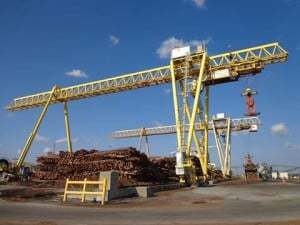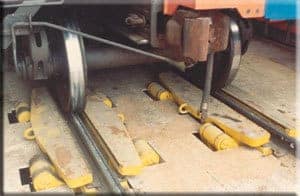Storm Brakes for Cranes Should be a Proactive Decision

Storm Brakes, Rail Clamps, Parking Brakes, Rail Brakes….are these terms you are familiar with? If you have experience working with outdoor cranes then most likely you have heard of them. However, these esoteric and niche brake systems are often foreign to many people in the industrial world.
Spring-Applied, Hydraulic Rail Clamps and Other Storm Brakes: How They Work
Storm Brakes are typically fail-safe brakes that are spring set and hydraulically released by a hydraulic power unit, although they can also be electric for smaller applications. Storm brakes function similarly to other industrial brakes except, instead of stopping or holding something (i.e. a rotating shaft) from moving, storm brakes act as “locking devices” to prevent external environmental conditions such as strong wind velocities from moving something where it shouldn’t go, such as a runaway crane. While they are commonly referred to as Storm Brakes, these brakes can be used to protect against other environmental threats and scenarios such as seismic movements, and holding down a retractable roof. Storm brakes take on various forms such as rail clamps, and Parking Brakes are similar brakes such as Wheel Brakes and Wheel Clamps and are used for protective measures as well. For outdoor cranes (i.e. Container Cranes), the Rail Clamp will apply to the rail, using the weight of the crane to push down and insure that there is sufficient holding force to protect the crane from moving when wind velocities up to a predetermined amount “push” against the crane. Of course, substantive engineering is involved in calculating the requisite holding force and several variables must be taken into consideration for this, but experienced personnel will understand these variables and choose the optimal Storm Brake for a given application.
Applications: Storm Brakes for STS, RTG, and RMG Cranes
Storm and Parking Brakes are vital for outdoor cranes, including Ship-to-Shore (STS), Rail-Mounted Gantry (RMG), and Rubber-Tyred Gantry (RTG) Cranes. Rail Clamps and Wheel Brakes are imperative to prevent a runaway crane accident from occurring and ultimately to stabilize the crane during hazardous conditions. Industrial Port Terminal Cranes are expensive and preventing downtime is critical for Port Operations to run efficiently, and Storm Brakes are a resource to insure uptime for your crane.
Precise Engineering for Storm Brakes is Critical

When it comes to Storm Brakes, there is essentially one reason why you have them: to protect your equipment from a rare, but potentially catastrophic occurrence from happening. I could go into detail about the “What-If” scenarios, but if you read this article about the Blount Island Crane Acccident in 2008 you will understand what I’m talking about. It is one of those things that typically go unnoticed, perhaps even forgotten for a while, but when the storm hits, everyone notices and it becomes the most important item on the menu. Lately I have seen more and more new crane construction projects where Storm Brakes (i.e. rail clamps) are a requirement and that means that people are certainly getting religion and understanding that they are as important as any other aspect of the crane. However, I still see many Outdoor Gantry Cranes and other applications where Storm Brakes are not being used and there is an accident waiting to happen. Furthermore, as in the aforementioned article about Blount Island, there is too often times where rail clamps are being utilized but either the incorrect ones were specified or the end user is not using them properly (or both) which essentially renders them useless.
Experience Matters: Kor-Pak Can Help with your Storm Brake Selection and Engineering
Everybody is good at something, and nobody can be good at everything. If you plan on acquiring Storm and Parking brakes for your industrial application, it is highly recommended that you contact someone who possesses the experience required to help you perform the necessary due diligence to offer a rail clamp that will properly align to your application and also offer the service and support needed to keep your equipment running at all times and answer questions when they come up. Kor-Pak is a primary resource for Storm and Parking Brakes and we invite you to contact us for more information and any questions you may have.

